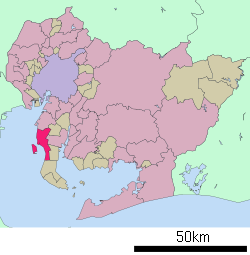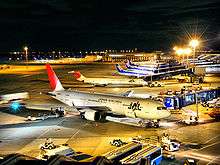Tokoname
Tokoname (常滑市, Tokoname-shi) is a city located in Aichi Prefecture, Japan. As of 1 October 2019, the city had an estimated population of 57,872 in 24,872 households,[1] and a population density of 1,035 persons per km². The total area of the city is 55.90 square kilometres (21.58 sq mi).
Tokoname 常滑市 | |
|---|---|
Tokoname ware tiles | |
 Flag  Emblem | |
 Location of Tokoname in Aichi Prefecture | |
 Tokoname | |
| Coordinates: 34°53′11.5″N 136°49′56.4″E | |
| Country | Japan |
| Region | Chūbu (Tōkai) |
| Prefecture | Aichi |
| Government | |
| • Mayor | Tatsuya Itō |
| Area | |
| • Total | 55.90 km2 (21.58 sq mi) |
| Population (October 1, 2019) | |
| • Total | 57,872 |
| • Density | 1,000/km2 (2,700/sq mi) |
| Time zone | UTC+9 (Japan Standard Time) |
| - Tree | Japanese Black Pine |
| - Flower | Camellia sasanqua |
| Phone number | 0569-35-5111 |
| Address | 4-1 Shinkai-chō, Tokoname-shi, Aichi-ken 479-0837 |
| Website | Official website |

Geography
Tokoname is located on the western coast of the Chita Peninsula in southern Aichi Prefecture, facing Ise Bay.
Demographics
Per Japanese census data,[2] the population of Tokoname has been relatively steady over the past 50 years.
| Historical population | ||
|---|---|---|
| Year | Pop. | ±% |
| 1960 | 51,919 | — |
| 1970 | 54,168 | +4.3% |
| 1980 | 54,343 | +0.3% |
| 1990 | 51,784 | −4.7% |
| 2000 | 50,183 | −3.1% |
| 2010 | 54,858 | +9.3% |
Climate
The city has a climate characterized by hot and humid summers, and relatively mild winters (Köppen climate classification Cfa). The average annual temperature in Tokoname is 15.5 °C. The average annual rainfall is 1674 mm with September as the wettest month. The temperatures are highest on average in August, at around 27.4 °C, and lowest in January, at around 4.6 °C.[3]
History
Tokoname has been associated with ceramics production since at least the Heian period, and Tokoname-yaki works from this period have been found in locations as far away as Aomori Prefecture in the north of Japan and Kagoshima prefecture in the south. By the Kamakura period, over 3000 kilns were active. During the Sengoku period, the area came under the control of the Isshiki clan, and later came under the rule of Oda Nobunaga and Toyotomi Hideyoshi. During the Edo period, the area around present-day Tokoname was part of Owari Domain.
In the post Meiji Restoration cadastral reforms of 1889, the town of Tokoname was created with the establishment of the modern municipalities system. Tokoname was elevated to city status on April 1, 1954 by the merger of Tokoname town with the towns of Onizaki (鬼崎), Nishiura (西浦) and Ōno (大野), and the village of Miwa (三和村).
Government
Tokoname has a mayor-council form of government with a directly elected mayor and a unicameral city legislature of 18 members. The city contributes one member to the Aichi Prefectural Assembly. In terms of national politics, the city is part of Aichi District 8 of the lower house of the Diet of Japan.
Chubu Centrair International Airport, built on an artificial island off the coast of Tokoname, opened on February 17, 2005, providing a major boost to local development.
Economy
Tokoname is a regional commercial center, and has been known since the Heian period for its production of ceramics, notably Tokoname-yaki, and ceramics production remains the mainstay of the local economy. One of the main producing companies is INAX.
About 60 climbing kilns formerly operated, most of which were constructed starting in the Meiji era. The chimneys became a landmark of the town, but many were closed and taken down after the Second World War as production methods modernised and burning of ovens was regulated by the authorities to protect the air quality. The Tōei Kiln (陶栄窯) is a climbing kiln (nobori-gama) that was constructed in 887 and used until 1974. It is the largest climbing kiln existing in Japan. It was designated as an Important Tangible Cultural Property by the government in 1982. It has eight firing chambers running a 17° incline and ten chimneys of varying height.
With its long coastline, commercial fishing also plays an important role in the local economy.
- "Pottery Footpath" (Yakimono-sanpomichi)
- The Tōei kiln, largest climbing kiln (nobori-gama) in Japan
- INAX MUSEUMS
 Old residence of the Takita shipping family
Old residence of the Takita shipping family
Education
Tokoname has nine public elementary schools, four public junior high schools operated by the city government, and one public high school operated by the Aichi Prefectural Board of Education.
Elementary Schools
- Miwa Elementary School
- Ono Elementary School
- Onizaki North Elementary School
- Onizaki South Elementary School
- Tokoname West Elementary School
- Tokoname East Elementary School
- Nishiura North Elementary School
- Nishiura South Elementary School
- Kosugaya Elementary School
Junior High Schools
- Tokoname Junior High School
- Onizaki Junior High School
- Nanryo Junior High School
- Seikai Junior High School
High School
- Tokoname Senior High School
Transportation
Airport
- Chūbu Centrair International Airport
Buses
Chita Bus (Chita Noriai)
- Kariya-Central Japan International Airport Route
- Tokoname Route
- Chintahanda - Narawabashi - Tokoname - Central Japan International Airport /- RinkuTokoname - Tokoname - Tokoname Public Hospital
- Tokoname South Route
- Kaminomae - Tokoname - *Central Japan International Airport/ - RinkuTokoname - Tokoname - Tokoname Public Hospital
- *All passengers going to Central Japan International Airport need to get a transfer ticket and change to Tokoname Route Services at Tokoname Station.
Tokoname City North Bus
- Tokoname Municipal Government - Tokoname - Tokoname Public Hospital - YadaCentral - Ogura Public Hall
Highways
.png)
.png)


Notable people from Tokoname
- Tetsuzō Tanikawa, philosopher, father of Shuntarō Tanikawa
- Kotaro Suzumura, economist
- The Peanuts, singers
- Tatsutoshi Goto, professional wrestler
- Tetsu Watanabe, actor
References
External links
![]()
- Official website (in Japanese) (with link to pages in English)